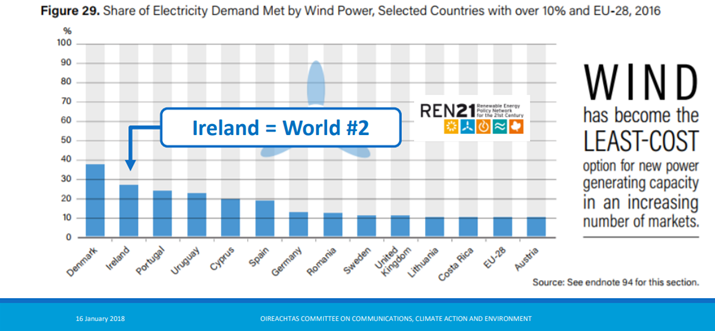Ireland’s energy system has gone through a major transformation over the past decade. What was once a system saturated with carbon intensive fossil fuels, such as coal and peat fired power stations, has transformed to a system with a high capacity of renewable energy.
Ireland’s renewable energy target for 2020, is reliant on new innovations in the electricity sector in relation to the integration of wind power. Wind power provides the majority of the renewable energy target. As a result, Ireland is now ranked second in the world, just behind Denmark, as one of the global leaders in relation to the integration of variable renewable electricity production.

Jean Claude Junker commented, “I want Europe’s Energy Union to become the world number one in renewable energies.” In tandem with this, The Copenhagen Accord, embraced the goal of limiting the rise in global temperatures to 2°C, therefore encouraging the reduction of carbon intensive energies. Significant progress has been made to date, with over 26% of Ireland’s electricity supply coming from wind power. Ireland produced a record capacity of renewable electricity last year, with the addition of a further 400MW of wind energy. Consequently, Ireland became a net exporter of electricity due to record production from wind energy.
Eirgrid famously tweeted back on the 3rd of January 2018, “Another record for all-island wind generation was set today: 3,331MW #StormEleanor. This was beaten again on the 12th of January at 20.50hrs with 3618MW of wind energy on the system. The overall system demand averages around 4500MW. If you would like to check the latest figures for yourself, you can check here: http://smartgriddashboard.eirgrid.com/#all/wind
However, with great advances in renewable energy Ireland could still face fines of up to half a billion Euro if targets are not met.

Fossil fuel import spending fell by €1.2 billion last year, following the opening of the contentious Corrib gas field. Coal and gas are however facing an increasing threat to their standing in the world’s electricity generation mix. This is due to remarkable reductions in the cost of solar, wind energy and batteries for storage, according to research from Bloomberg New Energy Finance (BNEF). BNEF’s latest report on the levelized costs of electricity for primary technologies uncovers that fossil fuel power is facing an unprecedented challenge in all three roles it performs in the energy mix. Namely, the supply of ‘bulk generation,’ ‘dispatchable generation’ and ‘flexibility.’
ESB’s coal-powered station Moneypoint, the biggest in the country and which cost more than €1.2bn to build and upgrade – is now valued at nothing [Irish Independent]. Bord na Móna [BNM] aims to phase out the generation of power from peat by 2030. It is BNM’s intention to develop a sustainable supply of biomass from both indigenous and international sources through a division called BNM BioEnergy. The share of wind and solar in total electricity generation in Ireland is expected to exceed 33% by 2022, according to the ‘Renewables 2017’ report from the International Energy Agency (IEA).

Source: https://bit.ly/2koa6dm
A report was launched by leading management consultancy Baringa at the Irish Wind Energy Association Spring Conference on the 21st March 2018. The study demonstrated that 70% renewable electricity by 2030 is not only technically feasible but is a ‘cost neutral solution’ for the Irish consumer, compared to an alternative 2030 fossil fuel scenario.
However, with increasing wind energy on the system – system intermittency issues come into play. The intermittent characteristic of wind is the greatest problem associated with wind power. As the installed capacity of wind increases, the problems associated with wind power become magnified. Since the wind does not always blow, it cannot be solely relied upon to provide power. Alternative generation (gas powered plants etc.) needs to be available to ensure system stability.
As wind penetration increases, curtailment of wind turbines also becomes an issue. Curtailment occurs when the amount of electricity generated from wind exceeds the demand requirement. Energy storage systems are possible solutions to this problem. Microsoft and GE have teamed up in Co. Kerry to solve this conundrum by fitting each wind turbine with an integrated battery. If the turbine produces more power than demand dictates, the excess is stored in the battery. If there are low wind speeds and not enough power is produced, the battery can top up the output.
If you’d like to hear about details of our news, events and updates, you can sign up up to our mailing list.


